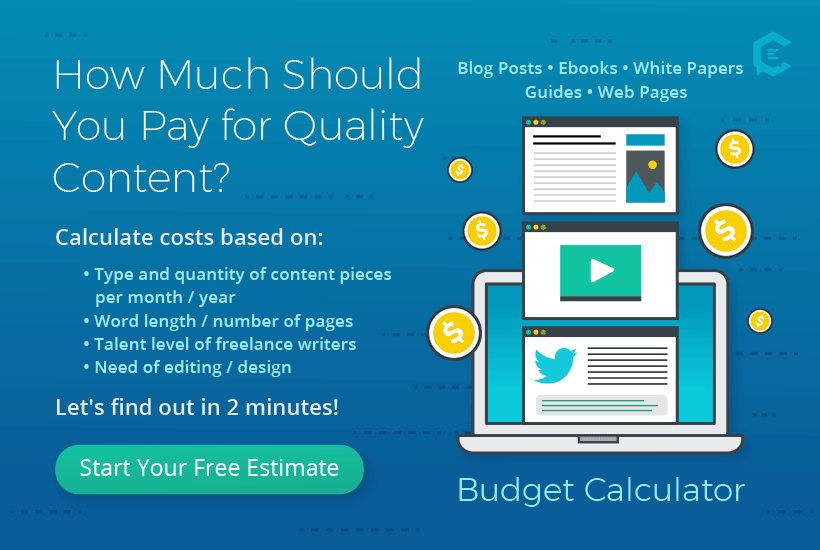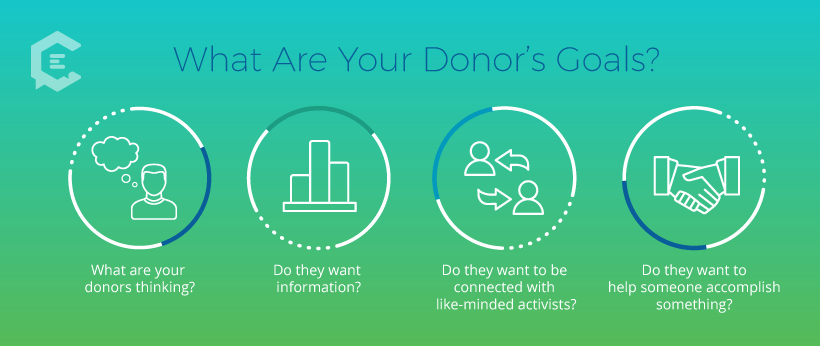Content marketing costs 62 percent less than outbound marketing and generates three times as many leads per dollar spent. (Source: Demand Metric). Organizers in the nonprofit and education sectors, especially those who are conscious of every donated dollar they spend, should embrace the high ROI of content marketing.
Many nonprofits feel overstretched budget-wise when it comes to maintaining a fully-staffed communications team, so many rely on freelance writers, editors and designers to help them develop content. Higher education institutions tap their alumni to make connections with each other, generating content to draw more alumni into donating to their alma mater.
How an organization gets their content done still relies on integral institutional steps to understand their audiences and tell their most authentic stories. Current trends around data analysis provide more considerations for nonprofits and universities in developing their communications plan, challenging them to tailor their message to specific donors in a more personalized way. Certainly, content managers might want to think about new strategies among best practices.
ClearVoice’s ebook, Content Marketing Best Practices: Higher Education & Nonprofits, offers a plethora of tools and strategies for starting up your content marketing. I found the book’s examples resonated with my own lessons learned as a seasoned nonprofit director. Given some new trends, I’ve added more tips for content marketing that could enhance the communications plan you may be developing for your nonprofit or higher education institution.
Also check out ClearVoice’s must-read post “Developing a Content Strategy: 25 Questions to Ask Your Team.” It includes a downloadable exam to help you button-up your strategy.
8 content marketing strategies for higher education institutions and nonprofits to understand their donors and authentically tell their stories
1. Segment your donors.
When program staff and nonprofit managers become more aware of their target audiences, they become clearer about how to craft nuanced messages, and begin framing their content towards getting specific results.
This may require some research and data analysis of your donor portfolios, but segmenting your donors, or grouping them into categories (such as place-based locale, giving amounts, or issue-based interests), will allow you to integrate storytelling, story gathering, program planning, and monitoring and evaluation all into your content marketing strategy.
2. Craft audience personas.
Tech companies like Facebook gather tons of information about you to fill your newsfeed with posts and ads that appear to read your mind and speak instantaneously and directly to your interests.
With some light research into your donors, nonprofits and higher education institutions can learn about donors and alumni by how they interact with your webpages, your calls to action, your social media feeds, and your e-newsletters and donation clicks. Nonprofits can use this data to create an audience persona, or multiple audience personas based on your donor segmentation research.
Communications Research Director Beth Hallowell of the American Friends Service Committee writes: “Audience personas can help your team create content for a more specific group of supporters than ‘the general public.’” These audience personas, developed and based on actual supporters (or potential ones), can give direction on how to create content in the personalized ways your donors like.
3. Plot your supporters’ journey.
When you ask people to take on your cause, it has to be something the donor feels speaks to their own goals.
- What are donors thinking?
- Do they want information?
- Do they want to be connected to like-minded activists?
- Do they want to help someone accomplish something?
How you craft your content will depend on what you believe is your supporters’ journey. Plot the supporters’ journey with clear calls to action and share relevant stories that help them see how supporting your organization’s cause or mission allows them to succeed in their own goals.
As Tom Latchford, CEO of Raising IT, explains your frame of reference for the content you create for donors needs to be approached from the “outside-in” rather than “inside-out” thinking. He warns that organizations often frame content from an internal projection of the organization onto the outside world, rather from the donor’s point of view. Make your content about the donor, not only about you and your organization.
4. Engage constituents in sharing their story.
Your most powerful, often overlooked, and untapped resources for authentic storytelling are the people you serve.
Some nonprofit communications directors or development directors may feel skittish about taking donors to meet constituents. Often the fear is that the people who benefit the most from a nonprofit’s programs will be “off-message,” while there is also a worry that having constituents share their personal stories may re-cast them in a negative light or victimize them again.
Yet with some initial investment of time and training, and sensitivity to constituents’ comfort in sharing their struggles, failures and successes, constituents who share their stories can become the nonprofits most impactful storytellers.
Constituent personal experiences ring true to donors in ways and words that scripted mission and vision statements cannot.
When a person who has benefited from your organization’s programs can speak to how effectively your interventions addressed their problems in unique, highly personal, and innovative ways, those stories reveal the profound ways in which your organization values and measures success.
These hints into the way your organization gives voice to your beneficiaries (or in the case of higher education, your students) goes a long way in building trust between your donors and your organization.
Taking the time to listen to their stories through the lens of your mission, helping them identify the through-lines of their narrative and your mission, not only helps you get an authentic message across, but also builds their skills to touch people on a deeply human level.
5. Allow for authentic voices to tell your organization’s story.
Nonprofits, whether they recognize it or not, naturally attract authentic storytellers, such as the domestic-violence-victim-turned-painter-and-social-activist, or the retired librarian who volunteers for two weeks to sort and stamp your newsletter or direct mail campaign who remembers the time your organization gave him a book as a young boy.
Your message drew them to you, and they want to give back, and share the purpose of your organization’s mission. That’s why they showed up.
To capitalize on this tremendous gift, I’ve often given constituents, staff and/or volunteers a choice of communications and storytelling activities from within a prescribed range of options and let them experiment with their chosen media tool for days or a few months at a time.
Afterwards, they share with me what they learned from the tool, assess the pluses and challenges, and then we decide whether this medium is a feature to keep in our content marketing strategy.
One time, we asked staff to show us through pictures and stories of how they came to work at our organization. Staff created 2- to 3-minute digital stories about an event in their lives related to the organization’s work.
Another time, I grouped volunteers to organize an art exhibit under one of our organization’s themes and program areas.
For both examples, the results surprised us.
We learned how our staff connected to our nonprofit’s work, and the intimate ways their programs became interwoven into their personal journeys. The stories were so rich and interesting, had our donors and constituents seen them, they would have felt a deepened relationship with our staff.
And the art exhibits became a regular program, helping us raise hundreds of dollars in donations.
6. Set clear guidelines on how individual stories highlight your organization’s mission.
Some precaution and clear guidelines should be established with constituents, volunteers and staff when their individual stories are used to highlight the organization’s work and mission.
Make sure you get signed waivers for all photographic images and text.
I make an extra effort to add time at the tail end of deadlines for stories to be properly reviewed for cultural and political sensitivities that might create difficulties for constituents, volunteers or staff whose stories are featured.
I also add disclaimer-like language in the “ask” part of the content to make sure donors know they are giving to the organization, not the individual, and that giving to the organization adds to the collective impact on the community at large.
One partner organization I worked with gave specific orientations to their donors and volunteers to make sure they did not make personal promises to individual families.
For an organization that leads mostly American donors and volunteers to build homes for families in developing countries, their communication strategy reflected the organization’s integrity and its attempts to avoid feelings of unintended race- and class-based patronage. Essentially, they didn’t want to replicate a missionary charity model.
When constituents and volunteers share their stories, we encourage them to share from our organization’s social media platforms (for closer ability to track user data), as well as on their personal feeds.
When possible, we made translations available, so that immigrant communities can share their successes among friends and family and the larger community, potentially attracting new people to our programs.
7. Build content marketing into your programming.
The power of digital stories and media training as a form of skills-based training and giving voice to your beneficiaries cannot be underestimated.
For disenfranchised communities, immigrant and refugee populations, such practice and training in communications, framing, messaging and media skills can be transformative for your constituents.
For colleges and universities, engaging your students in the planning, production and messaging of your content marketing gives them job skills and adds authenticity to your content.
When planning events and programming, consider how to capture the events; how to frame the story of each activity to your donors and supporters; or the policymakers you want to hear your perspectives.
When possible, plan to have all visits, talks and trainings documented through video, in pre-event montages or post-event interviews. Often this documentation cannot be done by staff delivering the programming, but could be an ideal job for a volunteer, student or intern to show your mission in action.
Nonprofits and higher education institutions often go to great lengths to plan events, delegations and meetings and calendar them a year in advance but neglect to create a communication plan/content marketing strategy for how to capture these experiences and share them widely to donor audiences.
8. Assess what content marketing strategies work best for your target audiences.
ClearVoice’s eBook, Content Marketing Best Practices: Higher Education & Nonprofits provides eight key steps to develop a dynamic content strategy.
Basically, it’s encouraging nonprofit and higher education leaders to think strategically about your communications and outline a plan; write it down; set measurable goals; and assess it. Remember not all steps have to happen in one year, nor do they have to take place in the order outlined.
When advising small nonprofits, I encourage high-level managers to consider three-year targets for their organization’s overall content marketing strategy. To get clearer reads, I recommend setting goals and assessing one or two of the organization’s programs as a pilot for the first year.
What I don’t always tell nonprofit leaders upfront but want them to discover for themselves is: The exercise of developing branding, the time taken to review and analyze the organization’s content, has incredible intrinsic value.
Often organization’s find a new voice, and articulate their work in fresh, more sensitive ways. Their clarity of language can uproot old organizational mindsets, and even change the ways in which an organization measures their success.
The intentional reflection on content also gives organizations a sense of how content cannot be completely universal in a one-size-fits-all that aims at reaching donors, partners, advocates and policymakers all at once. The more specific the message to the audience, the more clearly articulated the proposition, and the more likely and measurable the action.
Highlighting an organization’s impacts on the personal, community and social levels widen the net of who your content speaks most authentically to, while honing your organization’s relevance to current trends and social movements also opens links for you to connect with new donors, volunteers and supporters.








